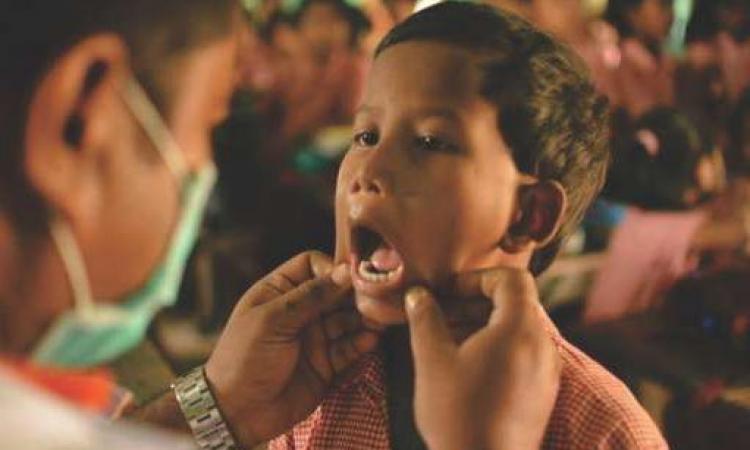
Farhanuddin was just five years old when a pain in his knee began bothering him. It was 2013. Slowly, his legs began to change shape. They got so badly deformed that it began to affect his everyday life. He was gloomy and tired most times and had trouble walking. His parents thought that lengra bhoot or evil spirit was tormenting them like hundreds of others who were becoming crippled in the village of Tapatjuri in Nagaon district in Assam. Little Farhan could barely eat, wash or take a stroll without assistance.
The village witch doctor, locally called bej, promised a cure through mustard oil, some invocation and negotiations with the evil spirit. Hoping the child might find some relief, Farhan’s father spent more than Rs 20,000 over the years on the witchdoctor but to no avail. The family was in the dark about the cause of his ailment; their drinking water source was a hand pump that contained a very high amount of fluoride (10 mg/l).
Fluorosis spreads in Assam
The first case of dental fluorosis in Assam was reported from Teklanjung village in Karbi Anglong district in June 1999. Following this, fluoride was tested in groundwater sources and found to be around 23.4 mg/l in some water sources in the area. Initially, when the problem of fluorosis was discovered, there was reluctance among people, the government departments and the civil society to accept it.
Studies by the Central Ground Water Board in November 1999 confirmed the presence of fluoride in Assam which paved the way for the UNICEF and the government to collaborate on fluoride mitigation. The additional chief engineer of the Public Health Engineering Department (PHED) in Assam, A.B. Paul played a significant role in identifying the presence of fluoride and later in developing and implementing an action plan to control it.
A technical collaboration with the Fluorosis Research and Rural Development Foundation (FRRDF) paved the way to understand its impact. The study, undertaken in Karbi Anglong as well as Nagaon districts, found thousands of fluorosis cases, some of them crippled for life. As a part of the Joint Plan of Action in Nagaon, health screening of school children and people in endemic areas was performed. The data on food habits, the source of drinking water and fluoride content were collected. Awareness campaigns were organised. Information, education and communication materials were prepared and distributed. Rapid appraisals were conducted in 22 districts of Assam. In the last two years, high fluoride is being reported in privately-owned tube wells in Guwahati, causing concern among people.
As per the fluoride map of Assam developed using the national water resource development plan database, as on April 2016, 11 districts, 24 blocks and 793 habitations were affected by fluoride putting a population of 3.9 million (rural) plus 0.6 million (in Guwahati city) at risk. A need was felt in government circles to quickly understand this tricky problem and find means to deal with it in places that have been affected.
Tale of Tapatjuri - a film by Nilutpal Das
Situation gets better slowly
The Fluoride Knowledge and Action Network’s (FKAN) involvement in Assam began with the support of Arghyam, a philanthropic organisation working on safe water and sanitation, in 2013 when they tried to understand field realities on fluorosis. This engagement at different levels culminated in setting up a state water quality and health resource centre and a field intervention centre. Rechristened later as SWaCHA (Safe Water Centre for Health Assam), the centre provides space to bring together those who want to act on issues related to water quality in Assam. The work of the field intervention centre, named Fluoride Mitigation Support Centre (FMSC) in Nagaon, in mitigating fluorosis through a "safe-water-and-nutrition" approach has been path-breaking since its inception.
Farhan was one such child identified by the centre. The work at Nagaon was inspired by the work of INREM Foundation in Jhabua, Madhya Pradesh. The safe-water-and-nutrition approach was tried first in a group of 20 children in Tapatjuri and a combination of nutritional supplement tablets (calcium, magnesium supplements and vitamin C through food) and safe water were provided to these children. The local administration provided extensive support in the effort by improving water supply schemes based on the advice of the network team and there was consistent work from local people in monitoring progress.
The progress these children made was monitored over a period of one year. Dramatic changes were observed in children. Bone deformities that were earlier thought to make the children differently abled for life were aborted, thanks to the innovative approach. Also, urinary fluoride was found to reduce significantly.
The Dikharumukh pipe water scheme in Tapatjuri improved the water situation and Farhan’s family was advised to drink water from either this or a pond close by after boiling. He was provided calcium and magnesium tablets apart from amla pickles regularly by the FMSC. By 2015, Farhan recovered and his legs are straight now. His urinary fluoride dropped from 60 mg/l to 1 mg/l and he can walk properly. He does not suffer from constant fatigue. Farhan has become a hope for other children of Tapatjuri.
This post is extracted from the attached policy brief. For more information on this issue, please visit the Fluoride Knowledge and Action Network's website. You can also write to Sunderrajan Krishnan and Vikas Ratanjee, and join FKAN on Facebook.
/articles/assam-continues-battle-fluorosis